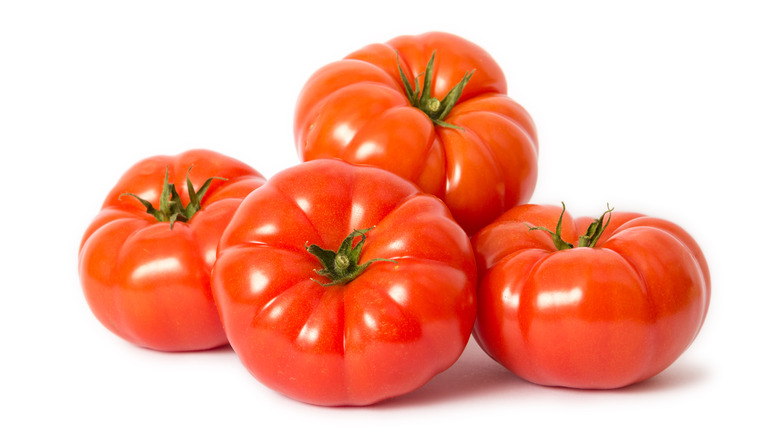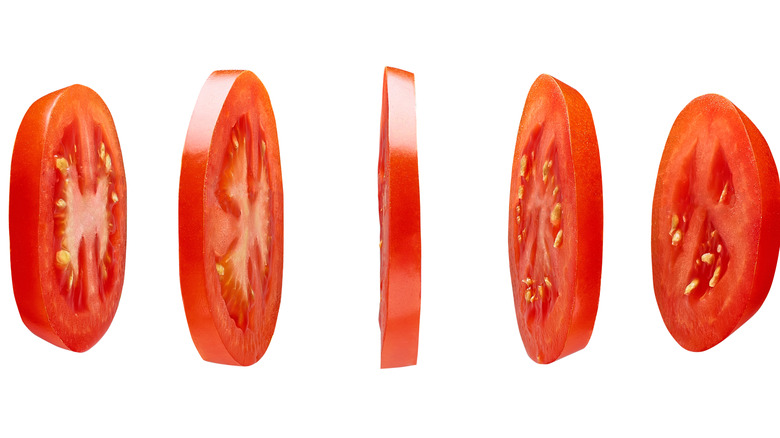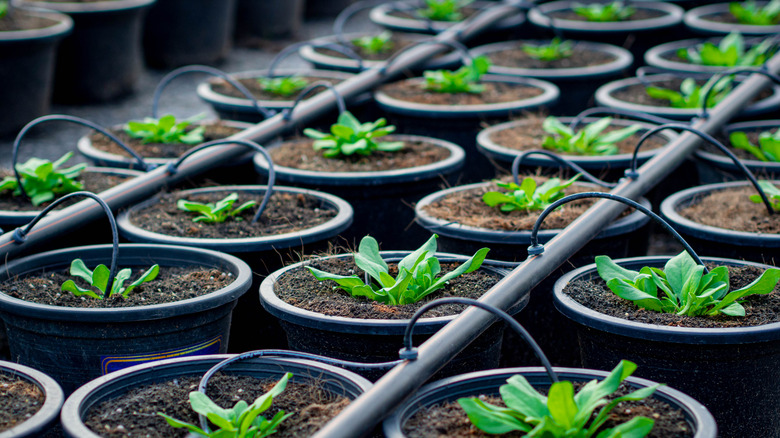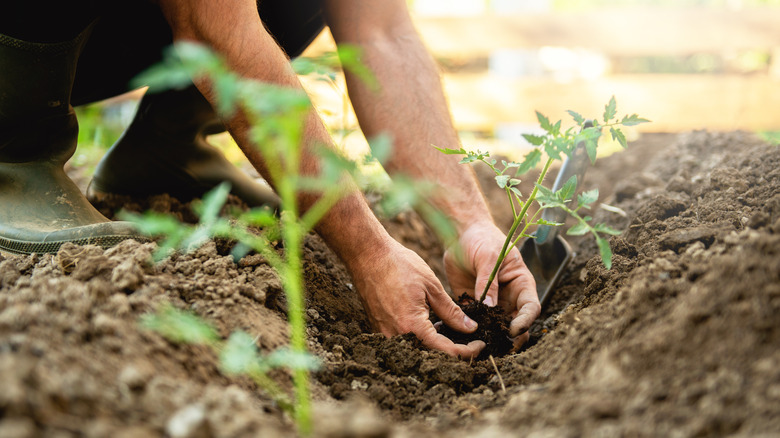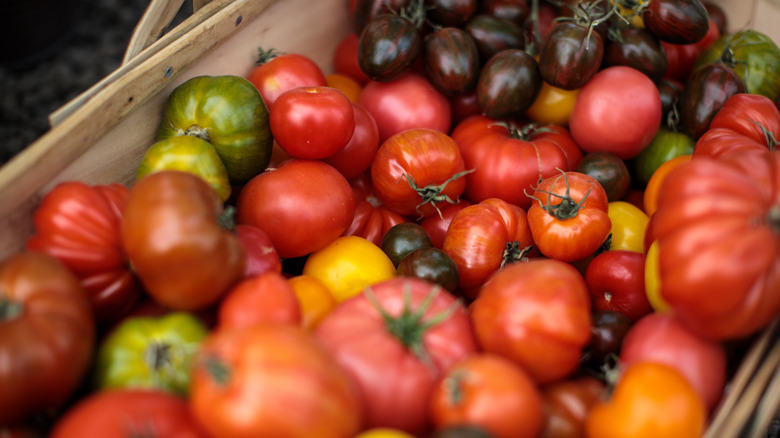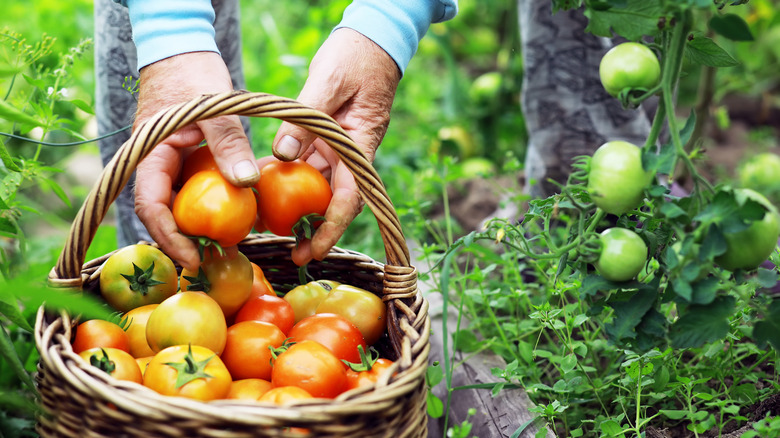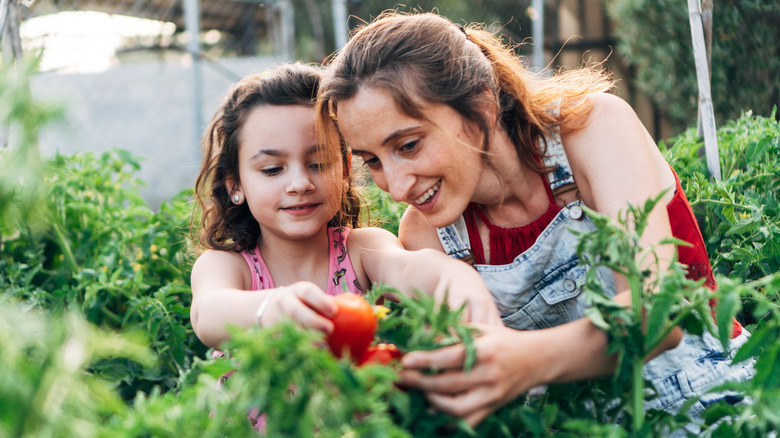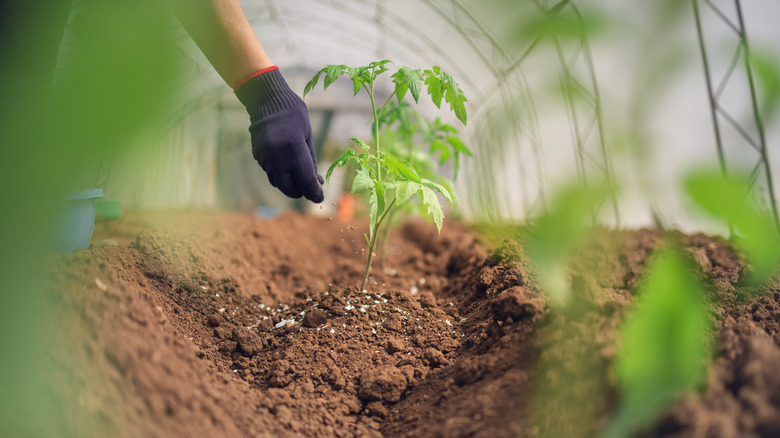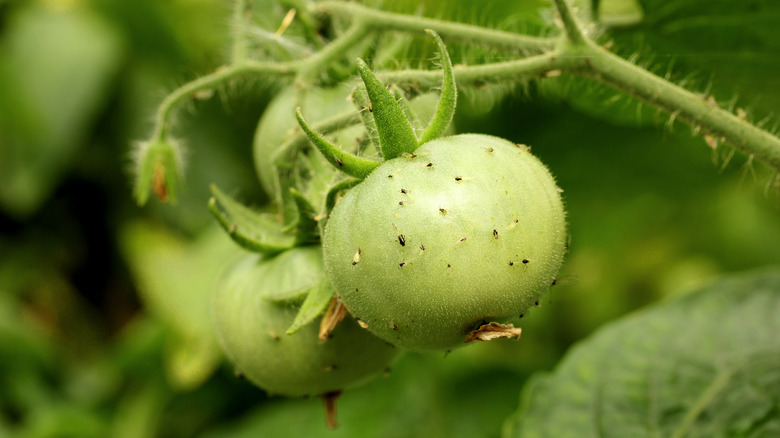How To Grow Beefsteak Tomatoes
Growing tomatoes in your backyard is one of the most rewarding gardening experiences you can have. With just a few square feet of space and a little know-how, you can grow tomatoes large enough to use in an appetizer, sauce, or salad and delicious enough to eat straight off the vine. Beefsteak tomatoes (Solanum lycopersicum "Beefsteak") are some of the largest and tastiest tomatoes around. They are a substantial, meaty variety that is perfect for slicing and serving on hamburgers or sandwiches, according to Gardening Channel. In fact, the beefsteak tomato is usually the largest variety of tomato grown in the home garden, with a single beefsteak often weighing more than 1 pound.
Beefsteak tomatoes can thrive outdoors in many parts of the country so that you can enjoy those delicious red fruits all summer long. However, growing beefsteak tomatoes can be a challenge. Luckily, there are a few tricks you can use to get your beefsteak tomatoes to thrive. This guide will walk you through the steps needed to get started growing beefsteak tomatoes in your backyard. We'll cover how to start tomato plants from seed as well as their sunlight, water, and soil requirements.
How to save beefsteak tomato seeds
You can purchase heirloom tomato seeds or seedlings at your local nursery or online, but if you have access to fresh beefsteak tomatoes, it's fun and easy to collect seeds from an organic source and start your own plants, according to Heirloom Organics. And because heirlooms are open-pollinated (as opposed to hybrids), you can collect the seeds from one year's crop and begin the next season's plants. All you have to do is replicate the natural fermentation process the tomatoes go through.
To extract seeds from the fruit, slice a fresh tomato in half lengthwise and scoop out the seeds — along with the gel around them — into a bowl. Leave the mixture of gel and seeds sitting out uncovered for several days so that a layer of mold forms on top of them. Only the good seeds will sink to the bottom, so pour off the bad ones floating near the surface and transfer those that have sunk down to a cup or small jar. Fill the container with cool tap water and cover with plastic wrap or aluminum foil. Store it at room temperature and repeat the process every few days until you see that the top layer has white mold on it and no more bubbles are coming up through the water. When you've harvested the best seeds, leave them out to dry for 12 days. Once they are dried, they will last for years before needing to be planted.
How to start beefsteak tomato seeds
Seeds should be started in a warm spot indoors about eight weeks before the last frost date for spring planting. This will give them time to mature and produce a good crop before the end of summer. Sow the seeds 1/4 inch deep in individual pots using a well-drained seed starting mix. Keep the soil moist and warm until germination occurs. Tomatoes germinate best when temperatures are between 70 to 80 degrees Fahrenheit, according to Slick Garden. They should take approximately 6 to 12 days to germinate.
Once all of your seeds have germinated, move the seedlings into a sunny window or give them supplemental lighting. If you don't have a sunny location available, grow lights can also be used to provide enough light for healthy tomato plants. After eight weeks, they should be about 8 inches tall, and they'll be ready to plant outdoors in larger containers or directly in the ground.
How to plant beefsteak tomatoes
Beefsteak tomatoes can be planted in the spring after the soil has warmed considerably and any threat of frost has passed. Choose a sunny location with rich soil that drains well and has been heavily amended with organic matter like compost or manure, according to Growing Greener World. Make sure there are no weeds in the area where you plan on planting the tomatoes. Use a hoe or other gardening tool to remove any weeds from the area you're going to plant in. Remove any rocks from the planting area. Dig up any rocks that might be buried just below the surface of the soil with a shovel or hoe. You don't want any rocks interfering with how your beefsteak tomato plants grow because they can get caught on roots.
Dig a hole deep enough so that the top two leaves of each seedling are buried and press gently down on the soil around it to remove air pockets and firm up the soil over your plant. Measure out the growing space. Beefsteak tomato plants need at least 2 feet of space between each other. If you're planning on planting more than one row, then leave 4 feet between rows (via Savvy Gardening).
According to the Gardening Channel, beefsteak tomatoes shouldn't be grown next to members of the Brassicaceae family, which include vegetables like kale, broccoli, cabbage, and cauliflower. They also shouldn't be placed alongside corn or potatoes.
Beefsteak tomato varieties
There are many varieties of beefsteak tomatoes, each of which has different advantages and uses, according to Food Gardening Network.
-
Big Boy tomatoes produce large and meaty fruit, making them perfect for slicing or adding to sandwiches. They have a pink hue that becomes bright red when mature. The fruits weigh 1 pound or more and have a sweet flavor.
-
Brandywine tomatoes are an heirloom variety that produces pink-hued fruit with a sweet flavor and weigh up to 2 pounds. The fruit has a distinctive heart shape that makes each tomato unique (via Gardening Channel).
-
Giant Belgium tomatoes produce a 1 pound fruit with pink flesh that has a sweet flavor.
-
Green Zebra tomatoes have green skin with yellow stripes and flesh that is pale yellow with green streaks when ripe. It has a complex sweet taste, which makes it an excellent choice for salads or sandwiches.
-
Porterhouse Hybrid tomatoes are massive, at 2 to 4 pounds each.
-
Cherokee Purple has a slightly smoky flavor that makes it unique but has a sweet aftertaste.
-
Hungarian Heart tomatoes originated in Belgium and are popular for their strong flavor and meaty texture.
How to care for beefsteak tomato plants
The soil for beefsteak tomatoes should be rich enough to provide the plant with plenty of nutrients, but it should also drain well, so the plant does not suffer from root rot. A good soil mixture includes compost and sand. In addition to providing nutrients, compost will help the soil retain moisture so that the plants do not dry out too quickly. If you're planting in containers, use a potting mix that's designed for growing vegetables and herbs.
Beefsteak tomatoes thrive in soil with a pH of 6.5 to 7.0, which is slightly acidic, according to Fine Gardening. Use a pH test kit for accurate results. Adjust the soil pH by adding lime to raise it or sulfur to lower it. The amount of either you should add depends on your soil's current pH and the type of soil. Wood ashes work as a pH amendment that also boosts potassium.
Beefsteak tomatoes thrive when exposed to a minimum of eight hours of sunlight daily, according to The Spruce. Tomatoes grown in areas that receive less than optimal light will ripen slower, become spindly, and produce fewer fruits. Pick a place that has good air circulation and is protected from strong winds.
Beefsteak tomato plants require 1 inch of water each week. If rainfall is inadequate, water your tomato plants regularly. Beefsteak tomato plants do not tolerate drought well and may drop flowers or form small fruits if they are deprived of water.
How to fertilize beefsteak tomatoes
Since beefsteak tomatoes are so large and produce such heavy crops, they need plenty of plant food to grow strong stems and healthy leaves in order to support their weight. To ensure that your beefsteaks have the nutrients they need throughout their growing season, start by mixing one part soil with one part compost or manure when planting.
According to Gardening Know How, tomato plants should initially be fertilized when planted in the soil. They don't need to be fertilized again until they start producing flowers. After the flowers appear, fertilize once every 1 to 2 weeks. Fertilize once a week again after each harvest, as long as you continue to pick fresh fruit from the plants.
The best type of fertilizer for growing beefsteak tomatoes is one that contains a high level of phosphorus, along with some potassium. This type of fertilizer helps the plant to develop strong roots and large fruit. A fertilizer that's too high in nitrogen will result in a leafy green plant that doesn't produce an abundance of fruit.
What type of fertilizer is best for beefsteak tomato plants?
Fertilizers are labeled with an NPK ratio which shows shoppers the balance of the three primary macronutrients: nitrogen (N), phosphorus (P), and potassium (K). Look for a fertilizer with an NPK rating of 5-10-5 or 5-10-10. If the natural soil proves to be short on nitrogen, you can opt for a more balanced NPK ratio of 8-8-8 or 10-10-10.
There are two types of fertilizer: water-soluble and granular. Each type is best suited for certain situations. Water-soluble fertilizers are applied by mixing the proper amount of fertilizer with water in a watering can and pouring it over the base of the plant, according to Bonnie Plants. This method is great for seedlings that need a rapid boost to get growing but isn't recommended for larger plants as it can burn them if not applied properly. Granular fertilizers can be worked into the soil at planting time or sprinkled around the base of a plant after it has started growing and watered in to dissolve the granules.
Preventing pests in beefsteak tomato plants
Tomato plants are generally pretty hardy, and while there's a chance you'll be able to avoid pesticides, there are certain pests and diseases you should be on the lookout for. Tomato Bible identified aphids as the most common pest for tomato plants. They can be white, black, or pink and are typically found on plant stems and the undersides of leaves. To remove them, try spraying the plant with a mixture of water and natural soap.
Another pest that tomato plants encounter are hornworms (via Almanac). These large caterpillars have green bodies and white stripes and can grow up to 4 inches long. They feast on tomato leaves, stems, and fruit — and can devour all of a plant's foliage in just a few days. Thankfully, hornworms are easy to spot; just look for their droppings on the ground beneath your plants or for the worms themselves on leaves or stems. Pick them off by hand or spray them with an insecticidal soap.
Cutworms can also destroy your tomato crop. The larvae of these nocturnal moths feed underground at night, eating the roots of young tomato plants until they die (via SF Gate). They then come out of hiding to eat above-ground parts of more mature plants as well. As their name suggests, cutworms will cleanly cut through a stem at the base of a plant, causing it to keel over and die. To combat these pests, try putting a cardboard collar around each seedling.
